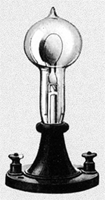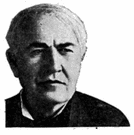Part 3: Everlasting Success He also invented things to improve the distribution of electricity, including sockets, switches, and insulating tape. Further cementing his reputation as the century’s greatest inventor, he built on the light bulb idea four years later by unveiling a system for distributing Edison wasn’t done, though. He invented the motion picture (movie) in 1890. In 1903, he unveiled The Great Train Robbery, a 10-minute silent movie. He also invented the dictaphone and the mimeograph. When World War I began, Edison went to work for the U.S. Government, inventing new defensive uses of rubber and concrete.
Today, it’s hard to go anywhere without encountering something that Edison invented or inspired. His influence is truly far-reaching, both in time and space. First page > Early Years > Page 1, 2, 3 |
|
Social Studies for Kids
copyright 2002–2024
David White

 electric light, heat, and power across a network. This meant that a large building, for instance, could run its electricity to many outlets from just one source, instead of having to install power sources at each individual light bulb or power station.
electric light, heat, and power across a network. This meant that a large building, for instance, could run its electricity to many outlets from just one source, instead of having to install power sources at each individual light bulb or power station.
 Thomas Edison received his last patent when he was 83. It was patent number 1,093. Edison died on Oct. 18, 1931. Millions of people dimmed their lights or turned off their electric power for a time in honor of the great contributions of the once-young man who lost his hearing but never his desire to learn.
Thomas Edison received his last patent when he was 83. It was patent number 1,093. Edison died on Oct. 18, 1931. Millions of people dimmed their lights or turned off their electric power for a time in honor of the great contributions of the once-young man who lost his hearing but never his desire to learn.
